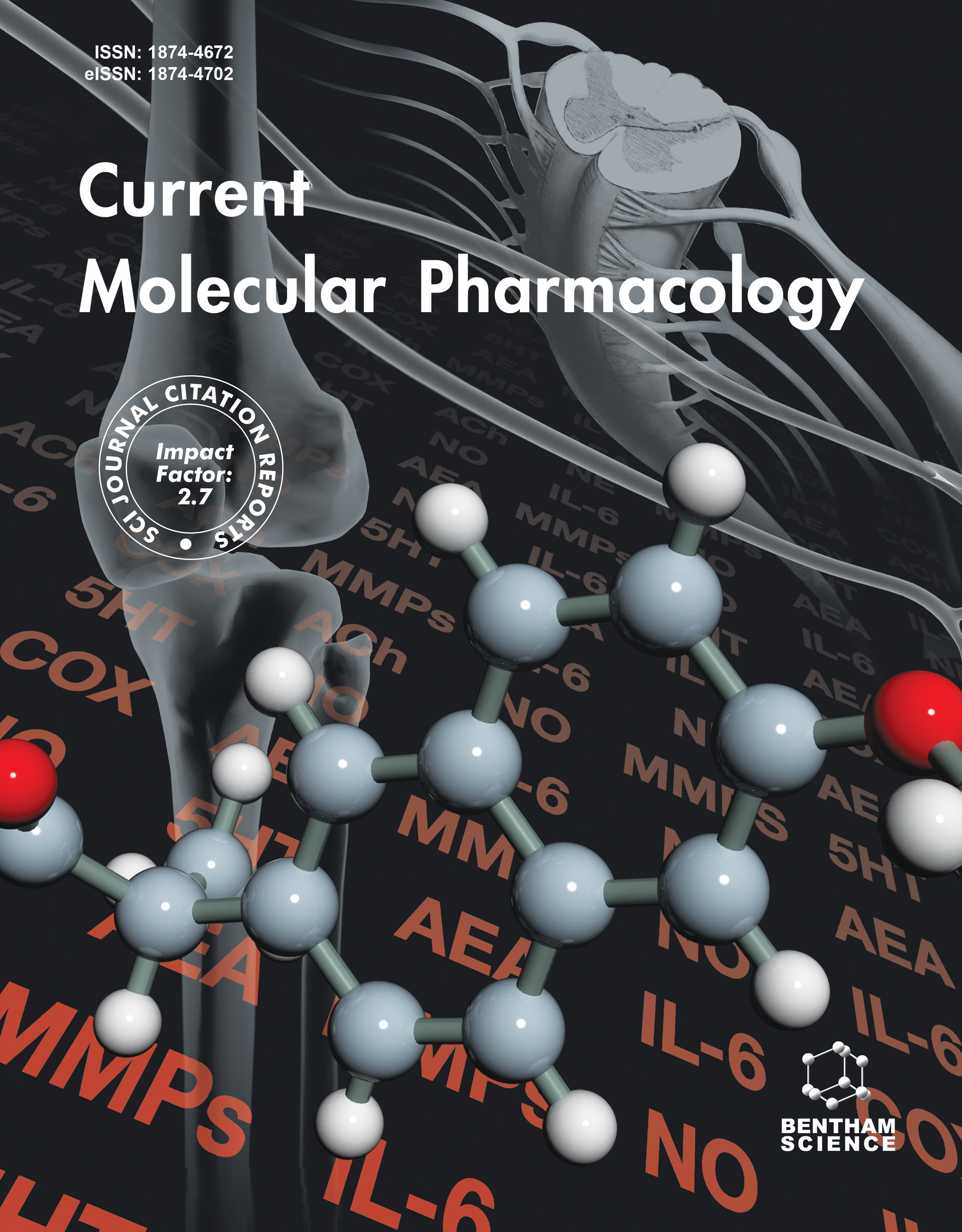- Home
- A-Z Publications
- Current Molecular Pharmacology
- Previous Issues
- Volume 15, Issue 2, 2022
Current Molecular Pharmacology - Volume 15, Issue 2, 2022
Volume 15, Issue 2, 2022
-
-
Harnessing the Natural Pool of Polyketide and Non-ribosomal Peptide Family: A Route Map towards Novel Drug Development
More LessThe emergence of communicable and non-communicable diseases has posed a health challenge for millions of people worldwide and is a major threat to the economic and social development in the coming century. The occurrence of the recent pandemic, SARS-CoV-2, caused by lethal severe acute respiratory syndrome coronavirus 2, is one such example. Rapid research and development of drugs for the treatment an Read More
-
-
-
Inactivation of Parathyroid Hormone: Perspectives of Drug Discovery to Combating Hyperparathyroidism
More LessAuthors: Amit Kumar and Jochen BalbachHormonal coordination is tightly regulated within the human body and thus regulates human physiology. The parathyroid hormone (PTH), a member of the endocrine system, regulates the calcium and phosphate level within the human body. Under non-physiological conditions, PTH levels get upregulated (hyperparathyroidism) or downregulated (hypoparathyroidism) due to external or internal factors. In case of hyperpara Read More
-
-
-
Reviewing Antiviral Research against Viruses Causing Human Diseases - a Structure-Guided Approach
More LessAuthors: Arunima Sikdar, Rupali Gupta and Evzen BouraThe smallest of all the pathogens, viruses, have continuously been the foremost strange microorganisms. Viral infections can cause extreme sicknesses as evidenced by the HIV/AIDS widespread or the later Ebola or Zika episodes. Apprehensive framework distortions are also regularly observed as consequences of numerous viral infections. Besides, numerous viral infections are of oncoviruses, which can trigger differe Read More
-
-
-
Wnt/β-catenin Antagonists: Exploring New Avenues to Trigger Old Drugs in Alleviating Glioblastoma Multiforme
More LessBackground: Glioblastoma Multiforme (GBM) is one of the most heterogeneous primary brain tumors with high mortality. In spite of the current therapeutic approaches, the survival rate remains poor, with death occurring within 12 to 15 months after the preliminary diagnosis. This warrants the need for an effective treatment modality. The Wnt/β-catenin pathway is presumably the most noteworthy pathway upregulated in al Read More
-
-
-
Alzheimer’s Disease and other Tauopathies: Exploring Efficacy of Medicinal Plant-derived Compounds in Alleviating Tau-mediated Neurodegeneration
More LessAlzheimer’s disease (AD), a major form of dementia, has been reported to affect more than 50 million people worldwide. It is characterized by the presence of amyloid-β (Aβ) plaques and hyperphosphorylated Tau-associated neurofibrillary tangles in the brain. Apart from AD, microtubule (MT)-associated protein Tau is also involved in other neurodegenerative diseases called tauopathies, including Pick’s disease, frontotemporal l Read More
-
-
-
Cytochrome bc1-aa3 Oxidase Supercomplex As Emerging and Potential Drug Target Against Tuberculosis
More LessAuthors: Thangaraj Sindhu and Pal DebnathThe cytochrome bc1-aa3 supercomplex plays an essential role in the cellular respiratory system of Mycobacterium Tuberculosis. It transfers electrons from menaquinol to cytochrome aa3 (Complex IV) via cytochrome bc1 (Complex III), which reduces the oxygen. The electron transfer from a variety of donors into oxygen through the respiratory electron transport chain is essential to pump protons across the membran Read More
-
-
-
Comprehensive Analysis of SARS-COV-2 Drug Targets and Pharmacological Aspects in Treating the COVID-19
More LessCorona viruses are enveloped, single-stranded RNA (Ribonucleic acid) viruses, and they cause pandemic diseases having a devastating effect on both human healthcare and the global economy. To date, six corona viruses have been identified as pathogenic organisms, which are significantly responsible for the infection and cause severe respiratory diseases. Among them, the novel SARS-CoV-2 (Severe Acute Respiratory Synd Read More
-
-
-
Structural Understanding of SARS-CoV-2 Drug Targets, Active Site Contour Map Analysis and COVID-19 Therapeutics
More LessThe pandemic, caused by Severe Acute Respiratory Syndrome Coronavirus 2 (SARSCoV- 2), is responsible for multiple worldwide lockdowns, an economic crisis, and a substantial increase in hospitalizations for viral pneumonia along with respiratory failure and multiorgan dysfunctions. Recently, the first few vaccines were approved by World Health Organization (WHO) and can eventually save millions of lives. Even thou Read More
-
-
-
Anticancer Effects of Tacrolimus on Induced Hepatocellular Carcinoma in Mice
More LessAuthors: Shireen S. Mahmoud, Samia Hussein, Hayam Rashed, Eman M. A. Abdelghany and Alaa I. AliBackground: Tacrolimus is a calcineurin inhibitor widely used for immunological disorders. However, there is significant controversy regarding its effect on the liver. The present study was conducted to evaluate the anticancer effects of tacrolimus on an induced murine hepatocellular carcinoma (HCC) model and its possible hepatotoxicity at standard therapeutic doses. Methods: Fifty-four male mice were divided into fi Read More
-
-
-
Assessment of Antioxidant Effect of Beta-Glucan on the Whole Blood Oxidative DNA Damage with the Comet Assay in Colorectal Cancer
More LessObjective: The present study aims to evaluate the antioxidant effect of beta-glucan on oxidative DNA damage by comet assay. Methods: A total of 19 adult females and males diagnosed with stage 3-4 colorectal cancer and a control group of 20 age-matched healthy subjects were enrolled in the study. Blood samples of the participants were analyzed using Comet Assay for the parameters of DNA damage. Results: Significantly Read More
-
-
-
Thioacetamide-Induced Norepinephrine Production by Hepatocytes is Associated with Hepatic Stellate Cell Activation and Liver Fibrosis
More LessBackground: Collagen production by activated hepatic stellate cells (HSCs) to encapsulate injury is part of the natural wound-healing response in injured liver. However, persistent activation of HSCs can lead to pathological fibrogenesis. Such persistent HSC activation could be mediated by norepinephrine (NE), a reaction product of dopamine beta-hydroxylase (DBH). Objective: To investigate the potential paracrine role of N Read More
-
Volumes & issues
Most Read This Month
Article
content/journals/cmp
Journal
10
5
false
en


